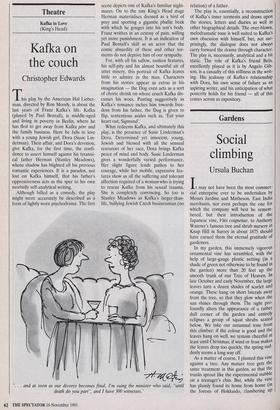Gardens
Social climbing
Ursula Buchan
It may not have been the most commer- cial enterprise ever to be undertaken by Messrs Jardine and Matheson, East India merchants, nor even perhaps the one for which the company will best be remem- bered, but their introduction of the Japanese vine, Vitis coignetiae, to Anthony Waterer's famous tree and shrub nursery at 1Cnap Hill in Surrey in about 1875 should have earned them the eternal gratitude of gardeners.
In my garden, this immensely vigorous ornamental vine has scrambled, with the help of large-gauge plastic netting (in a shade of green not otherwise to be found is the garden) more than 20 feet up the smooth trunk of our Tree of Heaven. In late October and early November, the large leaves turn a dozen shades of scarlet and orange. These hang on short laterals away from the tree, so that they glow when the sun shines through them. The sight pro- foundly alters the appearance of a rather dull corner of the garden and entirely eclipses a group of squat shrubs seated below. We take our autumnal tone from this climber: if the colour is good and the leaves hang on well, we remain cheerful at least until Christmas; if wind or frost makes the leaves drop too quickly, the spring sud- denly seems a long way off. As a matter of course, I planted this vine against a tree. Any mature tree gets the same treatment in this garden, so that the trunks sprout like the experimental stubble on a teenager's chin. But, while the vine has plainly found its home from home 01 the forests of Hokkaido, clambering up
trees is what it likes to do), not all climbers look so well.
It is an axiom of modern gardening that Plants are naturally sociable, and that they like to huddle together. By clothing every tree I have gone along with this, although in fact it ain't necessarily so. Plants differ in Characteristics and wants as much as the occupants of an Underground carriage, so We cannot blame them if some react as we Would if forced to huddle too close to other people in the Tube.
Roses, pace Gertrude Jekyll, are a decid- edly mixed blessing. They are too stiff, Once the older wood lignifies, to give that sinuousness which is appealing in this situa- tion. In addition, in the wild they scramble through scrub and thicket to reach the light, and natural pruning consists of a ran- dom shedding of dead wood. In the context of a garden, pruning for a good flowering Cannot be so simple or haphazard. I have, for example, the pretty pink-white noisette rose, 'Madame Alfred Carriere', climbing Up and through an old Victoria plum tree. The most vigorous shoots of this rose extend beyond the higher plum branches by several feet. An ordinary ladder is useless for pruning purposes, therefore, and a suit- able stepladder unobtainable. If I cut from below, I have the problem of somehow Pulling down dying branches without harm- ing the plum tree. Leaving them there is unthinkable.
A better bet, in this situation, might be a clematis but, even then, I should have to find the right one. The easiest to manage are those which naturally benefit from being cut down to a foot or so from the ground in the late winter; however, of these, only a few are vigorous enough to make a suitable impact, without clinging to the trunk like a frail Victorian maiden Clinging to a burly soldier who is anxious to be off to the wars. This means one's choice IS restricted to a few very strong-growing named varieties like 'Perle d'Azur' and Ville de Lyon', or one of the species Clematis.
.Fortunately, there is a small group of climbers which are more suitable for large trees than the clematis, and even less both- er. The so-called 'self-clingers' are those Plants, like Hydrangea petiolaris and Schizophragma integnfolium, which can stick like limpets to a rough surface like fis- sured bark and will happily take some
shade.
In addition, there are the annual or herbaceous climbers which die down natu- rally in the winter. A striking effect can be achieved if the scarlet 'flame flower', Tropaeolum speciosum, is planted to climb a .close-knit evergreen, like a yew tree. It w, ill not do at all in my thirsty alkaline soil, °tit I can achieve a similar impact with the orange-flowered- half-hardy climber, Eccre- nl'varpus scaber. It is vulgar in appearance, sh4ineless in its determination to get on, Yet unable to support itself by its own efforts. A true social climber, in fact.











































































 Previous page
Previous page